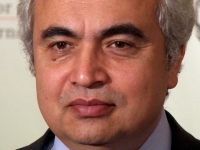
IEA urges flexible support for renewables and end to fossil fuel subsidies
Nov 3, 2012 - Lucy Woods - pv-tech.org
 |
| Renewables subsidies need to be doubled and fossil fuel subsidies are only benefiting middle and high income groups. Picture: Wikimedia/Mikhail Evstafiev. |
|
The International Energy Agency (IEA) has called for increased support for renewable energy through “flexible” tariffs and for the end of market “distorting” fossil fuel subsidies.
At the launch of the World Energy Outlook 2013 edition in London yesterday, IEA executive director, Maria van der Hoeven, said flexible tariffs would give renewables vital support but also but respond to price bubbles such as those that have affected PV due to over-generous feed-in tariffs (FiTs).
“Renewables need to be supported, but there must be a flexible tariff; in accordance with technology changes as prices go down, tariffs go down. So the grid infrastructure can manage,” said van der Hoeven.
The IEA World Outlook uses a ‘New Policy Scenario’ by using current, and announced but not yet implemented energy policies to predict energy markets figures, up to 2035.
The New Policy Scenario predicts that solar PV could increases its share of global energy generation from 0.4%, to 2.6% by 2035. To realise the increase in generation van der Hoeven said renewables need support and a stable framework: “If changes are being made to the law all the time it is not a stable investor market.”
Renewables subsidies totalled US$101 billion in 2012, and according to IEA figures would need increase to US$220 billion in 2035 in order to support a high level of deployment in the New Policies Scenario.
The outlook shows although there are implications for market deign and cost, non-hydro renewables’ expansion depends on the doubling of subsidies up to 2035. In the IEA’s New Policies Scenario used by the IEA, world electricity demand increases by more than two thirds between 2011-2035.
Fatih Birol, the IEA chief economist agreed with van der Hoeven that renewables subsidies were “crucial” but said renewable subsidy design should not put an “excessive burden on consumers and the economy”.
Birol also said there was a “huge untapped industry in energy efficiency”, mainly in Europe, stating “we must have sound energy policies in Europe, we must be careful”.
Two-thirds of energy efficiency market potential is on track to remain untapped in 2035, unless market barriers can be overcome, the IEA said in a statement, also today.
Another major debate raised at the conference was the use of fossil fuel subsidies. Birol said “fossil fuel subsidies are bad for countries, for the economy, for the environment, efficiency, and most of all for poor people”.
The IEA said the incentives for fossil fuels are a “wasteful consumption at a cost of US$544 billion in 2012” and that fossil fuel subsidies are distorting the energy market.
Birol said that 90% of fossil fuel subsidies are traced to middle and high-income groups, “so only these income groups are benefitting from the subsidies”. The IEA currently estimates that 1.3 billion people are lacking electricity.
Fossil fuels account for 82% of the energy market presently, the same as 25 years ago, and renewables decrease this to just 75% in 2035, according to the New Policies Scenario.
Renewables (and nuclear) are predicted to meet 40% of growth in energy demand, with half of net increase in electricity generation coming from renewables by 2035, with China to deploy more renewables than the EU, Japan and the US, combined.
Also in the statement released today, the IEA concluded: “Transition to a more efficient, low carbon energy sector is more difficult in tough economic times, but no less urgent.”

|